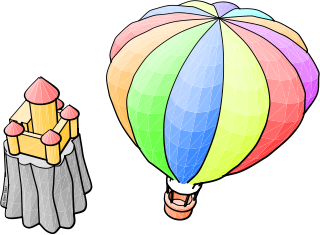
An object database or object-oriented database is a database management system in which information is represented in the form of objects as used in object-oriented programming. Object databases are different from relational databases which are table-oriented. A third type, object–relational databases, is a hybrid of both approaches.

Smalltalk is a purely object oriented programming language (OOP), created in the 1970s for educational use, specifically for constructionist learning, at Xerox PARC by Learning Research Group (LRG) scientists, including Alan Kay, Dan Ingalls, Adele Goldberg, Ted Kaehler, Diana Merry, and Scott Wallace.
Programming paradigms are a way to classify programming languages based on their features. Languages can be classified into multiple paradigms.
An object-oriented operating system is an operating system that is designed, structured, and operated using object-oriented programming principles.

Model–view–controller (MVC) is a software design pattern commonly used for developing user interfaces that divides the related program logic into three interconnected elements. This is done to separate internal representations of information from the ways information is presented to and accepted from the user.
VisualAge is a family of computer integrated development environments from IBM, which supports multiple programming languages. VisualAge was first released in October 1993 and was discontinued April 30, 2007 and its web page removed in September 2011. VisualAge was also marketed as VisualAge Smalltalk, and in 2005, Instantiations, Inc. acquired the worldwide rights to this product. IBM has stated that XL C/C++ is the followup product to VisualAge.

The history of programming languages spans from documentation of early mechanical computers to modern tools for software development. Early programming languages were highly specialized, relying on mathematical notation and similarly obscure syntax. Throughout the 20th century, research in compiler theory led to the creation of high-level programming languages, which use a more accessible syntax to communicate instructions.

Daniel Henry Holmes Ingalls Jr. is a pioneer of object-oriented computer programming and the principal architect, designer and implementer of five generations of Smalltalk environments. He designed the bytecoded virtual machine that made Smalltalk practical in 1976. He also invented bit blit, the general-purpose graphical operation that underlies most bitmap computer graphics systems today, and pop-up menus. He designed the generalizations of BitBlt to arbitrary color depth, with built-in scaling, rotation, and anti-aliasing. He made major contributions to the Squeak version of Smalltalk, including the original concept of a Smalltalk written in itself and made portable and efficient by a Smalltalk-to-C translator.

Kaleida Labs formed in 1991 to produce the multimedia cross-platform Kaleida Media Player and the object oriented scripting language ScriptX that was used to program its behavior. The system was aimed at the production of interactive CD ROM titles, an area of major effort in the early 1990s. When the system was delivered in 1994, it had relatively high system requirements and memory footprint, and lacked a native PowerPC version on the Mac platform. Around the same time, rapid changes in the market, especially the expansion of the World Wide Web and the Java programming language, pushed the interactive CD market into a niche role. The Kaleida platform failed to gain significant traction and the company was closed in 1996.

A class browser is a feature of an integrated development environment (IDE) that allows the programmer to browse, navigate, or visualize the structure of object-oriented programming code.
GemStone/S is computer software, an application framework that was first available for the programming language Smalltalk as an object database. It is proprietary commercial software.
Eclipse OpenJ9 is a high performance, scalable, Java virtual machine (JVM) implementation that is fully compliant with the Java Virtual Machine Specification.
Object Technology International (OTI) was founded in Ottawa, Ontario (Canada) in 1988 and acquired by IBM in 1996. OTI, in conjunction with the IBM development lab in Cary, NC, developed the VisualAge line Smalltalk and Java development tools that eventually culminated in the open source Eclipse tool platform and integrated development environment (IDE).
In computing, subject-oriented programming is an object-oriented software paradigm in which the state (fields) and behavior (methods) of objects are not seen as intrinsic to the objects themselves, but are provided by various subjective perceptions ("subjects") of the objects. The term and concepts were first published in September 1993 in a conference paper which was later recognized as being one of the three most influential papers to be presented at the conference between 1986 and 1996. As illustrated in that paper, an analogy is made with the contrast between the philosophical views of Plato and Kant with respect to the characteristics of "real" objects, but applied to software ones. For example, while we may all perceive a tree as having a measurable height, weight, leaf-mass, etc., from the point of view of a bird, a tree may also have measures of relative value for food or nesting purposes, or from the point of view of a tax-assessor, it may have a certain taxable value in a given year. Neither the bird's nor the tax-assessor's additional state information need be seen as intrinsic to the tree, but are added by the perceptions of the bird and tax-assessor, and from Kant's analysis, the same may be true even of characteristics we think of as intrinsic.
Object-Oriented Programming (OOP) is a programming paradigm based on the concept of "objects", which can contain data and code. The data is in the form of fields, and the code is in the form of procedures.
Harmony is an experimental computer operating system (OS) developed at the National Research Council Canada in Ottawa. It is a second-generation message passing system that was also used as the basis for several research projects, including robotics sensing and graphical workstation development. Harmony was actively developed throughout the 1980s and into the mid-1990s.






